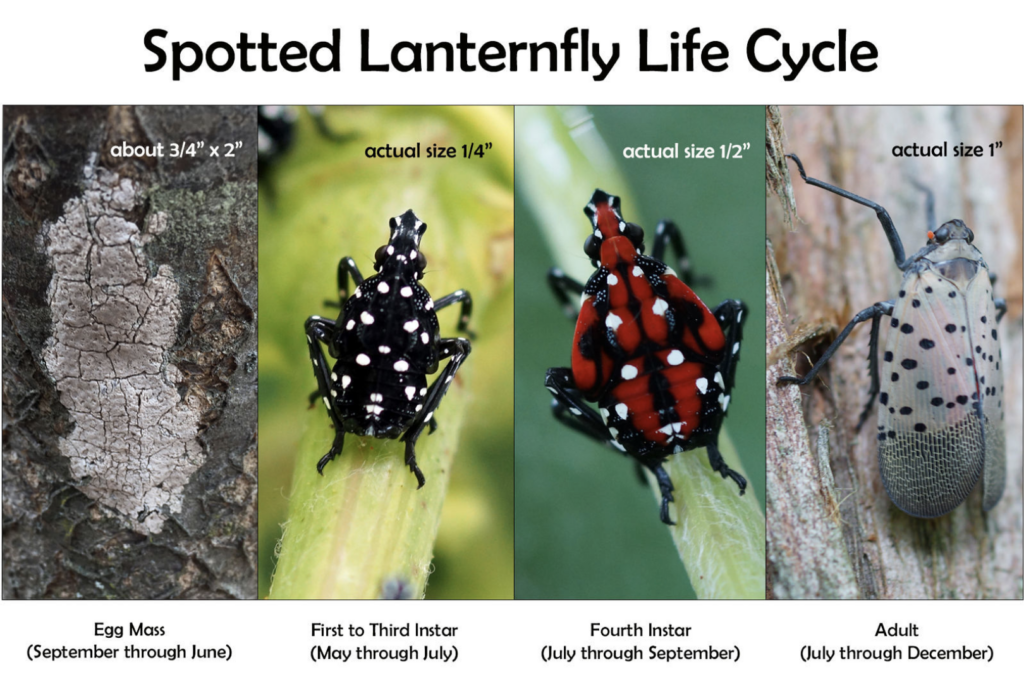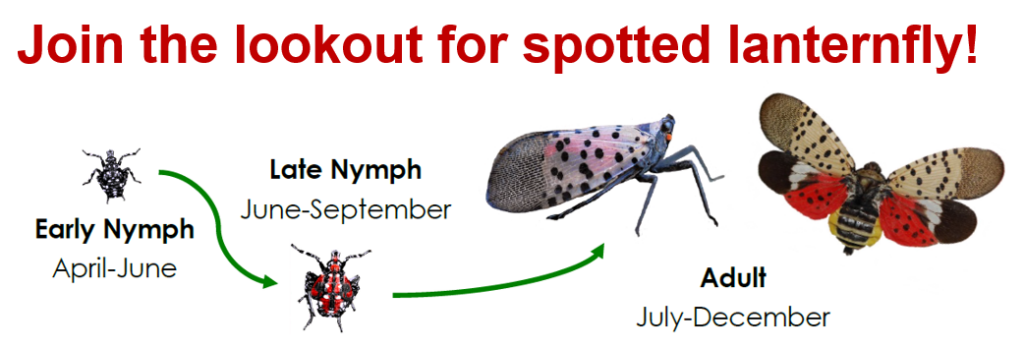NCDA&CS Finds Spotted Lanternfly in Caldwell County
go.ncsu.edu/readext?1079357
en Español / em Português
El inglés es el idioma de control de esta página. En la medida en que haya algún conflicto entre la traducción al inglés y la traducción, el inglés prevalece.
Al hacer clic en el enlace de traducción se activa un servicio de traducción gratuito para convertir la página al español. Al igual que con cualquier traducción por Internet, la conversión no es sensible al contexto y puede que no traduzca el texto en su significado original. NC State Extension no garantiza la exactitud del texto traducido. Por favor, tenga en cuenta que algunas aplicaciones y/o servicios pueden no funcionar como se espera cuando se traducen.
Português
Inglês é o idioma de controle desta página. Na medida que haja algum conflito entre o texto original em Inglês e a tradução, o Inglês prevalece.
Ao clicar no link de tradução, um serviço gratuito de tradução será ativado para converter a página para o Português. Como em qualquer tradução pela internet, a conversão não é sensivel ao contexto e pode não ocorrer a tradução para o significado orginal. O serviço de Extensão da Carolina do Norte (NC State Extension) não garante a exatidão do texto traduzido. Por favor, observe que algumas funções ou serviços podem não funcionar como esperado após a tradução.
English
English is the controlling language of this page. To the extent there is any conflict between the English text and the translation, English controls.
Clicking on the translation link activates a free translation service to convert the page to Spanish. As with any Internet translation, the conversion is not context-sensitive and may not translate the text to its original meaning. NC State Extension does not guarantee the accuracy of the translated text. Please note that some applications and/or services may not function as expected when translated.
Collapse ▲RALEIGH – The North Carolina Department of Agriculture and Consumer Services has confirmed an established presence of the invasive spotted lanternfly (Lycorma delicatula) in Caldwell County. Initial surveys indicate that the distribution of the pest is concentrated in Lenoir within a 1-mile area. Survey efforts are ongoing.


“NCDA&CS has surveyed for spotted lanternfly throughout North Carolina since 2015, and this is the first time a breeding population has been found in the mountains,” said Dr. Bill Foote, Director of the NCDA&CS Plant Industry Division. “Members of our Plant Industry Division are moving quickly to prevent the spread of this brightly colored pest, and we ask members of the public to be on the lookout for more spotted lanternfly and report any finds.
“Spotted lanternfly poses a serious threat to the state’s wine and grape industries and can feed and cause damage on over 100 species of plants including fruit trees, maples, and other common plants. They lack effective natural enemies in the U.S. and populations of this pest grow quickly, often becoming a nuisance.” said Dr. Foote.
“If left unchecked, swarms of thousands of lanternflies can form during the mating season, which peaks in September,” added Amy Michael, Entomological Programs Manager. “This unfortunately lines up with when the fall foliage in our mountains is most beautiful, and swarms of insects could certainly impact that view.”
Spotted lanternfly has a few other features that make it an unwelcome visitor. Lanternflies excrete a substance called honeydew – essentially sugar water – after digesting the plant sap it feeds on. Honeydew sticks around beneath plants infested with lanternflies, which can lead to additional problems like attracting ants and mold. Spotted lanternflies also hitchhike on people, vehicles and equipment, which has allowed to spread to 17 states so far.
“Spotted lanternflies like to feed high in the treetops, but they are not good at telling the difference between a truck tire and a tree trunk,” said Amy Michael, Entomological Programs Manager. “This new population most likely came from lanternflies hopping in with an unsuspecting traveler”. These insects often hitchhike to new areas on vehicles and equipment stored outdoors and can be moved any time of year. “Taking a moment to check your person and vehicle for these insects and removing any you see goes a long way in preventing this pest from spreading any further”, continued Mrs. Michael.
When spotted lanternfly populations were found in Forsyth and Guilford Counties in 2022, NCDA&CS dedicated teams to surveying and treating for spotted lanternfly to reduce the impact of this pest on North Carolina citizens. Spotted lanternfly was detected in a third location – Rockingham County – in Spring 2025. Caldwell County is now the fourth county with an established spotted lanternfly population in the state, and the first outside of the Triad area.
Surveys are expected to continue year-round in Caldwell County to determine if the pest is in additional locations. Treatments for spotted lanternflies are conducted by licensed NCDA&CS operators from April-October each year. Sites that have a high likelihood of spreading the pest to new areas, like commercial properties and lots under development, are prioritized for treatment. Residents seeking management recommendations are encouraged to reach out to their county’s Cooperative Extension Office at https://caldwell.ces.ncsu.edu/.
“Early detection and rapid response are critical in the control of spotted lanternfly and the Plant Industry Division is continuing to provide the most effective response to slow the spread of this invasive pest in our state”, Dr. Foote said.
If you see a suspect spotted lanternfly in North Carolina, please submit a picture through the online reporting tool at https://www.ncagr.gov/SLF.




